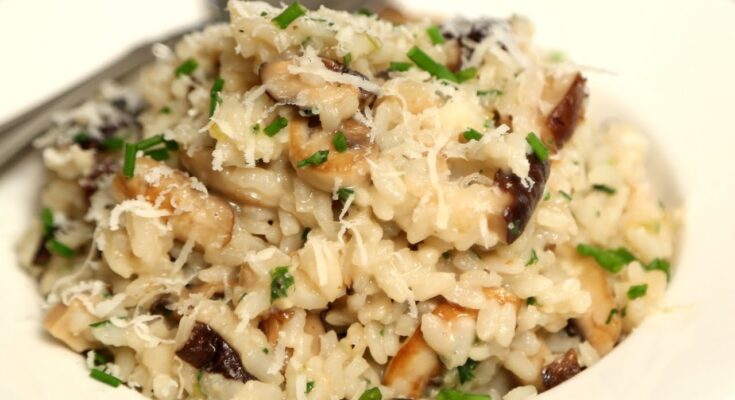Arborio Rice Recipe: Looking to master the art of cooking creamy, dreamy Arborio rice? Whether you’re a beginner in the kitchen or a self-proclaimed foodie, this step-by-step guide is your go-to source for crafting an irresistible Arborio rice dish.
With simple instructions, everyday ingredients, and a dash of kitchen wisdom, you’ll be serving up a restaurant-quality risotto in no time.
Introduction to Arborio Rice
Arborio rice isn’t your typical white rice—it’s the heart and soul of creamy risottos and luxurious rice-based dishes. What sets it apart? It’s short-grain, plump, and high in starch, which is what gives risotto its rich and velvety texture. Originally cultivated in Italy, Arborio rice is a must-have in Mediterranean cuisine, especially Northern Italian dishes.
When cooked correctly, the grains are tender on the outside with a slight bite in the center. That contrast in texture is what makes Arborio rice so addictive. And the best part? It’s incredibly versatile! While most people associate it with risotto, Arborio rice can also be used in rice pudding, soups, and even arancini (Italian rice balls).
You don’t need a culinary degree to whip up a perfect batch. With this guide, you’ll understand every step and technique like a pro—no guesswork involved.
Benefits of Cooking With Arborio Rice
Let’s talk benefits. Aside from its creamy texture and ability to absorb bold flavors, Arborio rice actually holds a few health perks. While it may not be as fiber-rich as brown rice, it still packs a punch in energy-boosting carbohydrates. It’s also naturally gluten-free, making it a safe choice for those with gluten sensitivities.
From a cooking standpoint, Arborio rice is a dream. Its starch content helps create thick, rich sauces without needing heavy creams or additives. The grains absorb stock and seasonings beautifully, so whatever flavor you’re infusing—herbs, wine, garlic—it will shine through in every bite.
Whether you’re making a hearty mushroom risotto or a light lemon version, Arborio rice adapts to your taste preferences and dietary needs. That’s versatility at its finest.
List of Ingredients You’ll Need
Here’s a simple ingredient list for a classic Arborio rice recipe (risotto style). These are pantry staples you likely already have at home:
Basic Ingredients:
- 1 ½ cups Arborio rice
- 4 cups low-sodium chicken or vegetable broth (warm)
- 1 medium onion, finely chopped
- 2 tablespoons olive oil or unsalted butter
- ½ cup dry white wine (optional, but highly recommended)
- ½ cup grated Parmesan cheese
- Salt and freshly ground black pepper to taste
Optional Add-Ons:
- 1–2 cloves garlic, minced
- Mushrooms (shiitake, cremini, or porcini)
- Fresh herbs (thyme, parsley, basil)
- A splash of lemon juice or zest
- Cooked shrimp, chicken, or crispy pancetta for protein
With this base, you can get as fancy or simple as you like. Think of it as a blank canvas—flavor it your way!
Kitchen Tools You’ll Need
Before you start, gather these essential tools. Cooking Arborio rice is all about timing and technique, so having the right equipment helps a lot.
- Medium to large saucepan or sauté pan
- Wooden spoon or silicone spatula
- Ladle (for adding broth gradually)
- Measuring cups and spoons
- Cutting board and sharp knife
- Cheese grater (for that fresh Parmesan)
Optional but helpful: A second small saucepan to keep the broth warm on a separate burner.
Having your mise en place (a fancy French term for “everything in its place”) ready will keep your cooking process smooth and stress-free.
Before You Start: Tips for Perfect Arborio Rice
Want perfect Arborio rice every single time? These tips will elevate your dish from good to gourmet.
1. Keep the Broth Warm
Always warm your broth in a separate pot. Cold broth drops the pan’s temperature, slowing down cooking and affecting the rice’s texture.
2. Don’t Rinse the Rice
Unlike basmati or jasmine rice, you don’t want to rinse Arborio. The starch is your friend—it creates that iconic creamy texture.
3. Use a Wide, Shallow Pan
This allows for more even cooking and easier stirring. A deep pot can cause uneven heat distribution and overcooked rice at the bottom.
4. Stir Consistently
Not constantly, but consistently. Stirring releases starch and prevents the rice from sticking. Too much stirring though? It can make it gluey.
A little patience and these pro tips will make all the difference.
Step-by-Step Guide to Cooking Arborio Rice
Ready to get cooking? Let’s break it down into easy-to-follow steps.
Step 1: Heat the Broth
Pour your chicken or vegetable broth into a small saucepan and keep it on low heat. You’ll be ladling this in gradually, and it should always be warm to maintain the rice’s cooking temperature.
Step 2: Sauté the Aromatics
In a wide saucepan, heat olive oil or butter over medium heat. Add finely chopped onions (and garlic if using) and sauté for about 3–5 minutes until translucent and fragrant—don’t brown them.
Step 3: Toast the Arborio Rice
Add the Arborio rice to the pan and stir it into the oil/onion mixture. Toast the rice for 2–3 minutes until it becomes slightly translucent around the edges. This helps lock in flavor and prepare the grains for absorbing the liquid.
Step 4: Deglaze with Wine (Optional)
Pour in the white wine and stir until the liquid is fully absorbed. This adds a rich, slightly tangy depth to the dish. If skipping wine, you can use a splash of lemon juice for brightness.
Step 5: Gradually Add the Broth
This is where the magic happens. Using a ladle, add one scoop of warm broth at a time. Stir gently until the liquid is absorbed before adding the next scoop. Continue this process for about 18–20 minutes.
Step 6: Finish With Butter and Cheese
Once the rice is tender with a slight bite (al dente), stir in the butter and freshly grated Parmesan cheese. Season with salt and pepper. At this point, it should be creamy, not soupy.
Take a taste—you just made restaurant-style Arborio rice at home!
How to Know When Arborio Rice Is Done
So, how do you know it’s ready? Simple—taste it. Perfectly cooked Arborio rice should be creamy yet still have a slight bite in the center of the grain, a texture Italians call al dente. You want it soft, but not mushy. Overcooked rice becomes sticky and gluey, while undercooked rice will be unpleasantly crunchy.
Another clue? The consistency. Arborio rice should not be dry or stiff. It should spread slightly on the plate but still hold its shape. Think creamy, not watery. When you run your spoon through it, it should part like soft waves and slowly flow back together.
You can also go by timing. Most risottos cook in about 18–22 minutes from the first ladle of broth to the final stir. But don’t rely solely on the clock—your taste buds are the best kitchen timer you’ve got.
Common Mistakes to Avoid
Even seasoned cooks can mess up Arborio rice. Here are the pitfalls you want to steer clear of:
1. Adding All the Liquid at Once
Resist the urge to pour in all the broth and walk away. Arborio rice needs time and gradual absorption to release its starches and develop that silky texture.
2. Not Stirring Enough
You don’t have to stir non-stop, but you can’t just let it sit either. Stirring helps activate the rice’s starch, giving your dish that creamy consistency. Think of stirring as love in motion.
3. Overcooking the Rice
Once the rice hits that perfect al dente texture, stop cooking. Continuing to stir and heat it will break down the grains and result in mush.
4. Skipping the Rest Time
Once the rice is done, let it rest off the heat for 2–3 minutes before serving. This allows the flavors to settle and the texture to stabilize.
Avoid these, and you’re well on your way to risotto greatness.
Serving Suggestions
Arborio rice is a star on its own, but pair it wisely and you’ve got a show-stopping meal. Whether you’re going for cozy comfort or elegant dinner vibes, here are some ideas:
Protein Pairings:
- Grilled shrimp
- Roasted chicken thighs
- Seared scallops
- Crispy pancetta or bacon
Vegetable Pairings:
- Roasted asparagus or Brussels sprouts
- Sauteed mushrooms
- Caramelized onions
- Wilted spinach with garlic
Wine Pairings:
- For a classic risotto: Pinot Grigio or Chardonnay
- Mushroom risotto: Pinot Noir
- Lemon or herb risotto: Sauvignon Blanc
Garnish with fresh herbs, a drizzle of olive oil, or even a sprinkle of truffle salt for added flair. You eat with your eyes first, after all.
Variations of the Arborio Rice Recipe
Once you’ve mastered the basics, the sky’s the limit. Let’s explore a few flavor-packed twists:
1. Mushroom Risotto
Add a mix of fresh and dried mushrooms, sautéed in butter, along with thyme and a splash of white wine. Earthy, savory, and comforting.
2. Lemon Parmesan Arborio Rice
Perfect for spring. Stir in lemon zest, lemon juice, and loads of grated Parmesan for a bright, tangy risotto that pairs beautifully with seafood.
3. Vegan Arborio Rice
Skip the cheese and butter—use nutritional yeast for a cheesy taste, and finish with olive oil and roasted veggies. Sub veggie broth, and you’re all set.
4. Seafood Arborio Rice
Add seared scallops, shrimp, or even clams toward the end. Infuse the broth with saffron for a subtle luxury kick.
5. Pumpkin or Butternut Squash Risotto
Creamy, cozy, and autumn-perfect. Add roasted squash purée and a pinch of nutmeg for a seasonal twist.
These aren’t just variations—they’re excuses to make Arborio rice again and again.
Storage and Reheating Tips
You’ve got leftovers? Lucky you. Here’s how to store and reheat Arborio rice without losing its creamy texture.
Storage Tips:
- Cool the rice quickly after cooking to prevent bacteria growth.
- Store in an airtight container in the fridge for up to 3 days.
- Freeze for up to 1 month, though texture may slightly change.
Reheating Tips:
- Add a splash of broth, water, or milk when reheating to revive creaminess.
- Reheat gently on the stove over medium-low heat, stirring often.
- Avoid microwaving if possible—it tends to dry out the rice.
If you’re planning to use it in arancini (Italian rice balls), slightly firmer rice works even better. Win-win!
Gluten-Free and Vegan Options
Good news—Arborio rice is naturally gluten-free. As long as you use a certified GF broth and check all labels (especially for cheese), you’re in the clear.
For vegan folks, just follow these swaps:
- Butter ➝ Olive oil or vegan butter
- Parmesan cheese ➝ Nutritional yeast or vegan cheese
- Chicken broth ➝ Vegetable broth or mushroom stock
You still get that luxurious texture and deep flavor, minus the dairy and animal products. The result? A dish that everyone at the table can enjoy.
Tips From Professional Chefs
Want to know what the pros do? Here are a few chef-approved hacks:
- Use homemade stock. The flavor difference is huge.
- Infuse your broth. Add herbs or mushroom stems to the broth while it simmers.
- Use a flat-bottomed spoon for better stirring and scraping.
- Rest your risotto. Let it sit for 2 minutes before serving for the creamiest texture.
- Finish with cold butter. Adds shine and silkiness.
It’s the little things that turn a good risotto into a great one.
Why This Recipe Works
There’s actual science behind this magic. Arborio rice contains a high level of amylopectin—a starch that dissolves when cooked and creates that creamy mouthfeel we all love.
By gradually adding warm liquid and stirring continuously, you coax out that starch slowly. The rice cooks evenly, the flavors meld, and the result is ultra-luxurious without a drop of cream.
Plus, using flavorful ingredients like wine, Parmesan, and aromatics adds layers of taste. It’s a dish where technique and patience make all the difference.
FAQs about Arborio Rice Recipe
1. Can I use Arborio rice for dishes other than risotto?
Absolutely! Try it in rice pudding, stuffed peppers, or arancini. It holds its shape well and adds a creamy texture.
2. What can I substitute for Arborio rice?
You can use Carnaroli or Vialone Nano as substitutes. Short-grain sushi rice can also work in a pinch, but expect slight texture differences.
3. Is Arborio rice healthier than regular white rice?
Nutritionally, it’s similar to white rice—high in carbs and low in fiber. But it wins in terms of texture and flavor absorption.
4. How do I keep risotto creamy when reheating?
Add a bit of broth or water before reheating and stir often. Reheat gently on the stovetop for the best texture.
5. Can I make Arborio rice in advance?
Yes, you can par-cook it (about 70%) and finish later. This is what many restaurants do for quick service.
Conclusion
Arborio rice isn’t just food—it’s an experience. From the first stir to the last bite, cooking it is an act of love. Whether you’re making a classic risotto, trying out a vegan version, or reinventing it with your favorite seasonal ingredients, the steps are the same—and the reward is always worth it.
Now that you’ve got the tools, tips, and confidence, it’s time to head to the kitchen. Pour a glass of wine, put on your favorite tunes, and stir your way to delicious comfort. Because with Arborio rice, every bite tells a story.



